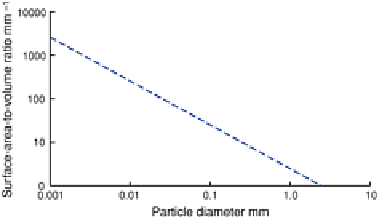Environmental Engineering Reference
In-Depth Information
Chemical properties of soils are also dependent on soil texture. The fine separate of
clay determines most of the chemical properties of soils. Particles with a diameter smaller
than 0·002 mm are classed as
colloids
, or are said to be in the
colloidal state
. Colloidal
properties arise from the very large surface area associated with a small mass. There is an
indirect relationship between particle size and the surface area of the particles. Assuming
for simplicity that particles are spherical and that the volumes of solid particles are equal,
the surface area of soils can be compared by using the value
R
(ratio of surface area to
volume for a particle of radius
r
):
Thus when
r
= 1 mm,
R
= 3 mm
−1
and when
r
= 0·001 mm,
R
= 3000 mm
−1
. Figure 18.2
illustrates the relationship between surface area-to-volume ratio and particle radius.
STRUCTURE
In the field the properties determined by soil texture may be considerably modified by
soil structure
. The solid mineral
Figure 18.2
The relationship between the diameters of
mineral particles in soil and their reactive surface areas
(surface area-to-volume ratio).
particles exist in a definite arrangement, and the pore spaces between them are filled
partly with water and partly with gases. The arrangement of individual particles into
larger
aggregates
or
peds
of various sizes and shapes is the
soil structure
. Although
'texture' and 'structure' seem to be used interchangeably in popular usage, there are real
differences in meaning. The small particles of clay and silt are not spread uniformly
throughout the soil. The clay coats sand particles. Individual clay units join together into
'clay domains' rather like the leaves of a topic. This is a kind of parallel orientation, with
the clay domains forming coatings around sand particles or soil structure units. A further
distinction between texture and structure lies in the role of organic matter. Humus or
humic colloids considerably influence the properties derived from texture. Organic matter
can improve the water-holding capacity of sand and can improve the drainage properties
of clay. This is achieved by promoting structure formation. Figure 18.3 illustrates how
clay colloids and humic colloids provide various types of 'bridges' or linkages between


